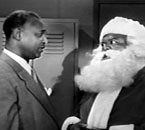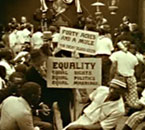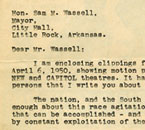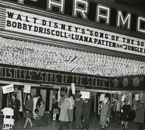Acknowledging the harmfulness to African Americans of stereotypes—and their ability to perpetuate white people’s racism by implying their superiority—civil rights leaders and organizations began to openly refute negative imagery.
In 1947, for example, the unaffiliated protests of the NAACP, the National Negro Congress, the black pictorial magazine, Ebony, and other institutions and individuals against Song of the South—the Disney studio’s paean to plantation life and black subservience in the Old South—helped educate the public to the problem at hand. Ebony, the most widely circulated African American picture magazine of the time, ran a two-page photo-editorial on Song of the South, declaring it “lily-white propaganda” that “disrupted peaceful race relations.” Media-savvy crusaders saw the film as a perfect target: aggressively marketed and widely reviewed, Song of the South was Disney’s first box-office hit since the end of World War II.
These protests anticipated an important tactic in the modern civil rights movement: the skillful, calculated use of the media to draw attention to the racism perpetuated by the media itself.
Image Credits/Captions (Click on thumbnails for full image)
TV Still: Amos n’ Andy, 1951. In a crusade against negative black imagery in the media, the NAACP, in the early-1950s turned its attention to the new medium of television, speaking out against two programs it deemed particularly offensive: The Beulah Show and the first television series with an all-black cast, The Amos ’n Andy Show, a half-hour situation comedy about a dialect-talking, self-deprecating businessman and his zany, shiftless business partner. The show emphasized vulgar character types—a dim-witted Uncle Tom; a crooked, scheming businessman; a dithering, listless janitor; and a nosy, loud-mouthed Mama.
Film Still: The Birth of a Nation, 1915
Letter from Effie Combs to Mayor Sam M. Wassell of Little Rock, Arkansas, April 12 1950. Two pages, 11 1/16 x 8 7/16 in. each. Collection of Civil Rights Archive/CADVC-UMBC, Baltimore, MD, 2005.184.1-2. The campaign against stereotypes was not confined to the demonstrations and boycotts lead by national civil rights organizations. In this letter and accompany newspaper clippings, a resident of Little Rock, Arkansas, urges the city’s mayor to appoint a “censor board” to regulate negative images that “exploit the Negro race.”
M.L. Cohen. “Protest Against Song of the South: Paramount Theater, Oakland,” April 2, 1947. Gelatin silver print. 8 x10 in. Collection of the Oakland Museum of California, Gift of Mr. Martin J. Cooney. Local civil rights groups picketed movie theaters in a number of American cities. On April 2, 1947, in downtown Oakland, California, protesters marched outside the Paramount Theater, bearing signs that read “We want films on Democracy, not slavery” and “Don’t prejudice children’s minds with films like this.” The popularity of Song of the South—it was Disney’s first box-office hit since the end of World War II—helped generate media coverage of the demonstration.



